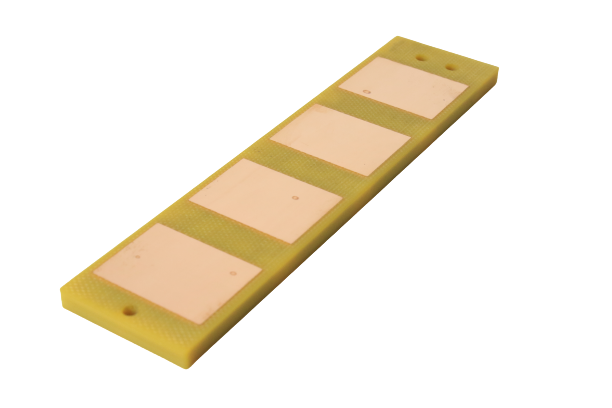IGBT Liquid Cooling
The insulated-gate bipolar transistor (IGBT) is among the most common semiconductors used in Power Electronics. Historically made from Silicon (Si), newer IGBTs are being fabricated from Silicon Carbide (SiC) and Gallium Nitride (GaN) for greater performance and thermal efficiency. While IGBTs play an important role in the delivery and conversion of power, they can also generate high levels of heat during high-frequency switching. A main priority of electric power designers is the cooling of IGBT devices. Mikros Technologies develops custom IGBT microchannel liquid cooling solutions to help you improve power performance, electrical efficiency, safety and reliability of your power electronics system.
Development of IGBTs
The IGBT is a solid-state switch that creates an electrical circuit by applying voltage to part of a semiconductor. It was first developed in the 1980s, and improved upon the invention of the metal oxide semiconductor field-effect transistor (MOSFET). The IGBT is unique because it suppresses the thyristor operation, which makes the device more efficient. IGBTs can be found in modern solar and wind turbine inverters, motor drives and power systems.
Thermal Challenges of IGBTs
IGBT thermal management is an essential part of an optimized power electronics system. IGBT modules can fluctuate in temperature and generate high thermal power depending on their use case, switching state and power input. Although IGBTs helped us make great strides with renewable energy, inefficiencies due to heat loss and operating temperatures continue to be a design limitation. Wire bond delamination due to material stresses from thermal expansion and contraction still presents the largest hurdle to IGBT operation. This has prompted IGBT designers to consider innovative cooling solutions that help increase the power capacity and lifetime of their devices.

IGBT Cooling Solutions
There are several cooling options that can help with IGBT thermal management. Each solution has its own advantages.
Air Cooling
Using air-cooled heat sinks can be a quick and cost-effective option for lower power devices. For some industrial designs, air-cooled systems utilize a heat sink with large mass and thermal capacitance to absorb heat spikes. Due to the heat-carrying capacity of air and often high ambient operating temperatures, air-cooled heat sinks have a harder time managing higher temperatures and thermal spikes in high power electronic devices. This makes air cooling an economical option for low- and mid-power devices only.
Direct Liquid Cooling
Direct liquid cooling improves heat transfer coefficients and decreases the thermal resistance of a system, lowering the junction temperatures and increasing power capacities in IGBTs. Liquid cooling also allows designers to achieve greater power per volume, which increases performance and energy efficiency. Direct liquid cooling historically has taken the form of large copper tube cold plates swaged into aluminum blocks with a thermally conductive epoxy. Other designs include machined channels in copper, increasing efficiency. Embedded designs provide a pin-fin heat sink in the direct-bond copper (DBC) substrate, which is then mounted to a fluid reservoir, providing a flow of coolant over the fins for convective cooling.
Microchannel Liquid Cooling
For high power designs, the lowest thermal resistance achievable comes via an innovating microchannel liquid cooling design. Using integrated microchannel liquid cooling can lower the thermal resistance of an IGBT 10x-100x over other liquid cooling designs by reducing the thermal mass of the coolant in micro-sized flow channels. This dramatically improves heat dissipation rates and lowers the operating temperatures of IGBT system designs. Mikros Technologies microchannel cold plates optimize microchannel thermal physics to provide even better performance. Our microchannel matrix designs can be tailored to fit IGBT module specifics and can provide unparalleled and consistent thermal management for power electronics.
Power Electronics Applications
Over the last few decades, IGBTs have become mainstream in power electronics applications. There are several types of devices and systems that rely on IGBTs for power.
Inverters
IGBTs are ideal for inverters thanks to their exceptional gate control and ability to carry higher currents. Advanced cooling options provide an even smoother transition from DC to AC power using IGBT modules.
Converters
IGBTs are used to provide electric power for voltage converters. Converters play a major role in the design of power supplies.
Power Supplies
There are two types of power supplies supported by IGBTs:
Switch Mode Power Supply (SMPS)
SMPS uses a switching regulator to convert voltage and currents, and IGBTs can help with high-current applications.
Uninterruptible Power Supply (UPS)
When an electrical system fails, an IGBT can help a UPS deliver seamless, consistent power.
Induction Heating
IGBT devices are common in induction heating applications. High power heaters can be optimized by implementing a microchannel cooling solution.
Traction Motor Control
Commonly used in the railway and electric vehicle (EV) industries, traction motors support propulsion applications. These industries require the stable, high-current power that IGBT power modules offer. A more efficient cooling solution for traction IGBTs like Mikros microchannels can reduce the energy used during operation, providing more power and longer battery life.

Renewable Energy Applications
A growing number of commercial, industrial, and municipal entities are implementing renewable energy solutions into their strategic plans. Optimized IGBT liquid cooling with a microchannel solution can help generate more sustainable energy at a lower cost for consumers.
Solar Inverters
Concentrated Photovoltaic Receivers (CPVs)
Solar Assisted Heat Pumps
A solar-assisted heat pump involves the integration of a conventional heat pump with photovoltaic input to lower heat generation costs. Microchannel cold plates for the IGBT power modules can improve energy efficiency, lower the total cost of ownership for the system.
EV Charging
Faster charging for the emerging electric vehicle market is strongly in demand. Many EV chargers use high power IGBT devices that must be liquid-cooled to provide high current inputs while maintaining critical safety standards. Microchannel liquid cooling of these charging modules can dramatically improve their performance and energy efficiency.
Contact Us Today
As a premier designer and manufacturer of microchannel cold plate designs for IGBTs, Mikros Technologies designs cooling solutions for all these industries and more. For more information about our microchannel liquid cooling solutions, call (603) 690-2020 or contact us online today.